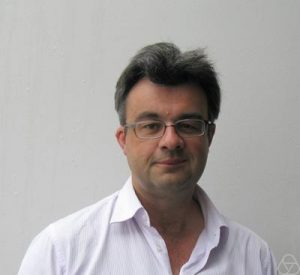
Emmanuel Candès (Source Wikimedia)
Emmanuel Candès has won a prestigious MacArthur Fellowship. The official announcement is here. The LA Times has a nice write-up. Both the Los Angeles Times and the MacArthur announcement highlight Candès’s work on compressed sensing. Terry Tao has a spot-on reaction to this work, quoted in the LA Times, typical of most mathematicians when you first hear about the method: you can’t be getting be getting something for nothing. This can’t work. But it does! Tao finally came around to believe it, as has the rest of the world.
Candès is a collaborative researcher. The work on compressed sensing came out of conversations he was having initially with researchers in imaging science (MRIs). He tested out his ideas in conversations with Tao (while picking up their children at daycare, according to the legend). In MathSciNet, you can see that Candès has 48 coauthors, representing a wide variety of people: statisticians, analysts, younger collaborators, older collaborators.
One of his key publications on compressed sensing is his paper with Justin Romberg and Terry Tao in Communications on Pure and Applied Mathematics, Stable signal recovery from incomplete and inaccurate measurements. For your reading enjoyment, our review of it is reproduced below. The complete article is here.
Congratulations, Emmanuel Candès!
MR2230846
Candès, Emmanuel J.(1-CAIT-ACM); Romberg, Justin K.(1-CAIT-ACM); Tao, Terence(1-UCLA)
Stable signal recovery from incomplete and inaccurate measurements.
Comm. Pure Appl. Math. 59 (2006), no. 8, 1207–1223.
94A12
The authors consider the problem of recovering an unknown sparse signal x0(t)inBbbRm from nllm linear measurements which are corrupted by noise, building on related results in [E. J. Candès and J. K. Romberg, Found. Comput. Math. 6 (2006), no. 2, 227–254; MR2228740; E. J. Candès, J. K. Romberg and T. C. Tao, IEEE Trans. Inform. Theory 52 (2006), no. 2, 489–509; MR2236170; E. J. Candès and T. C. Tao, IEEE Trans. Inform. Theory 51 (2005), no. 12, 4203–4215; MR2243152; “Near optimal signal recovery from random projections: universal encoding strategies?”, preprint, arxiv.org/abs/math.CA/0410542, IEEE Trans. Inform. Theory, submitted; D. L. Donoho, Comm. Pure Appl. Math. 59 (2006), no. 6, 797–829; MR2217606]. Here x0(t)is said to be sparse if its support T0=lbracetcolonx0(t)neq0rbrace has small cardinality. The measurements are assumed to be of the form y=Ax0+e, where A is the ntimesm measurement matrix and the error term e satisfies VerteVertl2leepsilon. Given this setup, consider the convex program minVertxVertl1rmsubjectto;VertAx−yVertl2leepsilon.;;;(textrmP2)
The authors define AT, Tsubsetlbrace1,ldots,mrbrace, to be the ntimesvertTvert submatrix obtained by extracting the columns of A corresponding to the indices in T. Their results are stated in terms of the S-restricted isometry constant deltaS of A [E. J. Candès and T. C. Tao, op. cit., 2005], which is the smallest quantity such that (1−deltaS)VertcVert2l2leVertATcVert2l2le(1+deltaS)VertcVert2l2 for all subsets T with vertTvertleS and coefficient sequences (cj)jinT.
Their main results are below. The first describes stable recovery of sparse signals, while the second yields stable recovery for approximately sparse signals by focusing on the S largest components of the signal x0.
Theorem 1. Let S be such that delta3S+3delta4S<2. Then for any signal x0 supported on T0 with vertT0vertleS and any perturbation e with VerteVertl2leepsilon, the solution xsharp to (rmP2) obeys vertxsharp−x0vertl2leCScdotepsilon, where the constant CS depends only on delta4S. For reasonable values of delta4S, CS is well behaved; for example, CSapprox8.82 for delta4S=frac15 and CSapprox10.47 for delta4S=frac14.
Theorem 2. Suppose that x0 is an arbitrary vector in BbbRm, and let x0,S be the truncated vector corresponding to the S largest values of x0 (in absolute value). Under the hypotheses of Theorem 1 in the paper, the solution xsharp to (rmP2) obeys Vertxsharp−x0Vertl2leC1,Scdotepsilon+C2,ScdotfracVertx0−x0,SVertl1sqrtS.
For reasonable values of delta4S, the constants in the equation labelled 1.4 in the paper are well behaved; for example, C1,Sapprox12.04 and C2,Sapprox8.77 for delta4S=frac15.
Reviewed by Brody Dylan Johnson

This type of great research works because of the adherence to standards and excellence of each of the contributors and constructs like commutative properties in linear algebraic functions. Also advances in infrastructure, technology, and sound foundational architecture development of frameworks are an enabler and constant for any research done these days. Cheers to the author and congratulations.